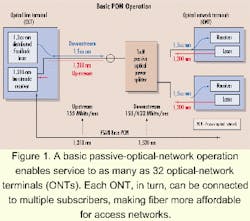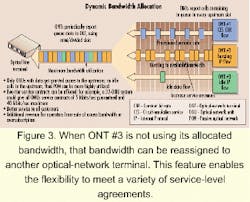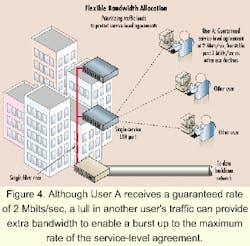Dynamic bandwidth allocation over passive optical networks
Access technologies using PON architectures provide carriers with scalable bandwidth and services to meet growing customer demands.
Siddhartha Devadhar and Kevin Ryan, Terawave Communications
Today's carriers are racing to meet the broadband-services needs of businesses and home users. The number of people and businesses demanding broadband services is far outstripping the current networks' capabilities. Passive optical networks (PONs) are emerging as the access technology of choice to meet the needs of today's carriers as well as providing the scalability to meet the bandwidth and services requirements of the future.
The evolution of PONs is being led by a consortium of 22 of the largest service providers in the world. This consortium, Full Service Access Network, has already standardized a basic specification for PON in ITU-G.983.1 and is actively working to evolve this standard to meet the needs of tomorrow's access network.PON architectures provide affordable high-speed optical bandwidth in the access space, economical deployment and maintenance, and seamless scaling from T1 (1.554 Mbits/sec) to lambda services. The architecture accommodates the churn in the network and is topology-independent. Point-to-multipoint communications, a feature critical in today's broadband-services requirements, are inherent with PONs to provide higher value service offerings.
Basic PON operation is shown in Figure 1. One of the key differentiators of PONs as compared to other optical telecommunications technologies is the ability to serve multiple (up to 32) optical-network terminals (ONTs) over a single fiber. In turn, each ONT can connect to multiple subscribers depending on the network design. This point-to-multipoint architecture makes fiber affordable.
As currently defined in the standards, the basic PON operates either at 155 Mbits/sec bidirectionally or in an asymmetric mode of 622 Mbits/sec downstream and 155 Mbits/sec upstream. The need for bidirectional 622-Mbit/sec operation has been recognized for higher-end business applications and is being carefully considered. This bandwidth is divided between many subscribers on the same single-fiber strand. The optical line terminal (OLT) broadcasts data downstream on 1,510 nm and the ONTs burst data back upstream on 1,310 nm in their assigned time slots.The first generations of PONs worked much like the time-division multiplexing (TDM) equipment in that bandwidth or circuits were "nailed up" to a subscriber. Once bandwidth was assigned to a subscriber, it was unavailable to other subscribers on the network. For example, if ONT #1 was assigned 2 Mbits/sec of bandwidth and it went idle at some point in time, the 2 Mbits/sec of bandwidth went unused and was not available to other subscribers on the network.
Such assignment of bandwidth results in twofold degradation in network utilization. First, the nailed-up bandwidth of idle connections is wasted, translating into unrealized revenue for the service providers. Simultaneously, the bursting connections are constrained to the bottleneck of the pre-provisioned bandwidth, which causes significant buildup of queues at the edge of the network that could lead to data loss if the buffers overflow. This architecture was designed for lower levels of traffic consisting of T1s and voice traffic (see Figure 2).
Dynamic bandwidth allocation (DBA) is the ability to quickly reapportion bandwidth on the PON based on current traffic requirements. The granularity of allocation can range from the coarse (per ONT) to the very fine (quality-of-service [QoS]-based priority-level queues or even individual flows on each ONT). The method of apportioning bandwidth can be determined by policy and subject to the individual subscriber's service-level agreement (SLA) or contract with the provider.
Strictly speaking, if the PON is considered in its entirety, it is a limited resource with fixed maximum bandwidth of either 155 Mbits/sec or 622 Mbits/sec. As long as the total "instantaneous" bandwidth needs of all ONTs on the PON do not exceed capacity, the PON can function as a delivery vehicle without significant data accumulation in the ONT buffers. In essence that utilizes the notion of statistical multiplexing (stat-muxing) of data traffic. Stat-muxing relies on the fact that the bursty data traffic of user applications leads to time-varying peaks and valleys in the data rates required. Stat-muxing exploits the high likelihood that the peaks of the various applications' data rates will not be concurrent. It allows the PON to be over-provisioned with more ONTs (and hence, more customers).DBA harnesses stat-muxing by apportioning part of the instantaneously available bandwidth to particular ONTs or to specific classes (implemented as QoS queues) within each ONT, as when necessary in accordance with the SLA. From the point of view of an ONT (or a queue within), the connecting "pipe" always has exactly enough bandwidth to match the data rate at low PON utilization levels. When the PON traffic load is high, DBA ensures the guarantees of the SLA first, redistributing the remaining bandwidth in a predetermined manner.
With the advent of the Internet's business-to-business and business-to-consumer activity, network traffic has changed dramatically, leading to a new network dominated by bursty Internet Protocol (IP) traffic. These new applications for the wide area network do not fit well in the existing circuit-based network architectures designed primarily for carrying voice and other synchronous traffic. As the network moves from providing predominantly T1 or circuit-based services to packet-based data services, new ways of provisioning and managing services and bandwidth become more important.
With DBA, service providers can offer integrated services that combine time-sensitive synchronous services, such as voice, with asynchronous data services on the same infrastructure. That also allows service providers the ability to flexibly deliver SLAs.
Under the static bandwidth-allocation scenario (nailed-up circuit architecture), subscribers are required to pay for a bandwidth level regardless of usage. Choosing the peak rate may equate to paying for a lot of unused bandwidth. Choosing valley rates may result in bursty traffic that is constrained by the limited provisioned bandwidth.
Although the actual answer lies somewhere in the middle, it's difficult to estimate the requirements. With DBA, service providers can offer services that guarantee some minimum rate, while allowing the subscribers to burst up to some maximum rate. This approach enables service contracts that more effectively fit the needs of today's business subscribers.SLAs for Internet traffic usually consist of a committed information rate and a maximum burst rate. For example, a user may subscribe to a guaranteed rate of 2 Mbits/sec with a maximum rate of 10 Mbits/sec. As shown in Figure 3, when ONT #3 is not using the bandwidth allocated to it, that bandwidth can be reassigned to another ONT. In this example, ONT #2, which is bursting data traffic, can benefit from the excess available bandwidth. Without DBA, the unused bandwidth would be stranded and unusable by other ONTs on the network.
Under static bandwidth-allocation models, the maximum bandwidth guaranteed would be limited to just under 4.8 Mbits per node in a 32-node system (155 Mbits/32 nodes = ~ 4.8 Mbits/sec). Using a DBA-enabled PON, the service provider can sell guaranteed bandwidth of 4.8 Mbits per node of committed information rate with the ability to burst up to a much higher rate (i.e., 40 Mbits/sec). As bandwidth from the nodes becomes idle, it can be reallocated to the uncommitted portion of the other ONTs. As bursty data traffic becomes the dominant component of network traffic, DBA ensures efficiency of the access network. A correctly implemented DBA scheme maximizes the bandwidth benefits of stat-muxing. With DBA, service providers can sell more aggregate bandwidth than the total size of the pipe.
Figure 4 shows the effective use of DBA to flexibly allocate the bandwidth of the PON across the users on the network. In this example, User A is receiving a guaranteed rate of 2 Mbits/sec when the other users are fully utilizing their network. If a lull occurs in one user's traffic, unused bandwidth becomes available and is reassigned to User A, who can now burst up to the maximum rate of the SLA.
PON traffic using DBA may be oversubscribed in two ways. In the first scenario, only traffic in excess of the committed rate is oversubscribed. Thus, the sum of the maximum rate of all subscribers is higher than the PON capacity. However, the sum of the guaranteed rates is still below network capacity.
In the second case, even the guaranteed bandwidths are oversubscribed. This scenario uses a notion akin to that of concentration used in standard analog service and other traditional networks. Based on extensive traffic measurements, it has been shown that the long-term average utilization of networks is below the 30%-to-40% range. As a result, higher revenue can be achieved through oversubscribing guaranteed rates, while still meeting the SLA and QoS commitments of the subscriber. DBA gives the service provider the ability to decide the oversubscription that is appropriate for the provider's network and customers.DBA-enabled PON also allows service providers to attach different levels of quality to different streams of traffic out of the same ONT (see Figure 5). That allows enterprises to intelligently allocate bandwidth among mission-critical streams of data, such as network backup and noncritical uses. An example of this application is a user with a 2-Mbit/sec service; by dividing this aggregate service into priority classes, the subscriber can be provided differentiated services.
For example, during normal operation, most of the bandwidth is available to the lower-priority class and can be used by people in the office for Internet browsing. When the company begins a database backup or a customer transaction is being processed, the bandwidth is allocated to the mission-critical network backup. DBA also enables quick adoption to new services at customer sites. When a subscriber signs up for a high-quality service such as video conferencing, the service is automatically given priority on the PON.
While the need for DBA exists, a broad spectrum of possibilities arises for its implementation. A minimum DBA that provides rigid priorities at the ONT level is still better than static partitioning of bandwidth across the PON. At the other end of the spectrum, a more sophisticated DBA scheme can include priority levels and multiple queues within each ONT, enabling each ONT to receive differentiated treatment for real-time and non-real-time applications.
A well-engineered DBA strategy must address several service-related issues. To maintain QoS, all real-time services would require faster response to bandwidth requests. Similarly, circuit-emulation-services traffic would have to be granted first to minimize cell delay variation and jitter. To provide fair treatment across multiple ONTs, a bandwidth request should always identify the class of service.
DBA must also enforce the guaranteed (minimum) and excess (maximum) bandwidth limits on each identifiable grant. After ensuring the guaranteed bandwidth requirements have been allocated, the DBA should distribute the excess bandwidth fairly. Finally, DBA must be extremely fast to reduce latency and satisfy the needs of real-time traffic.
Siddhartha Devadhar is senior manager of applications and planning and Kevin Ryan is director of business development at Terawave Communications (Hayward, CA).





